List of public statues of individuals linked to the Atlantic slave trade
This is a list of public statues of individuals with links to the Atlantic slave trade.
United Kingdom
| Statue | Location | Description | Ref | |
|---|---|---|---|---|
| Statue of John Cass | 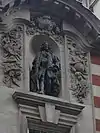 |
31 Jewry Street, London | John Cass was one of the major developers of the Atlantic slave trade and had direct business contacts with slave agents in the Caribbean and African forts.[1] An 18th-century lead statue of Cass by Louis-François Roubiliac, commissioned by the Sir John Cass Foundation, was sited for many years on Aldgate High Street, but was moved to the John Cass Institute in Jewry Street in 1869. It was removed to the Guildhall in 1980. A fibreglass replica was placed in the empty niche of the John Cass Institute in Jewry Street in 1998.[2] Several copies have been made; one is sited in the entrance lobby of the London Metropolitan University Archive.[3] | [4] |
| Statue of Sir Francis Drake |  |
Plymouth Road, Tavistock | Sir Francis Drake was involved with capture, transport, and sale of slaves across his career, and was particularly influential in establishing early British slave trade.[5][6] | [7] |
| Statue of Thomas Guy | 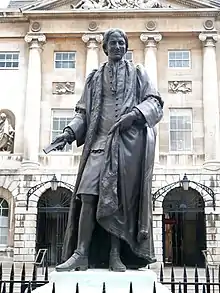 |
Forecourt of Guy's Hospital, London | Thomas Guy owned a substantial shareholding in the South Sea Company.[1] Guys and St Thomas' NHS Foundation Trust said in a statement that they would work with the Commission for Diversity in the Public Realm to "...consider the right way forward. We recognise and understand the anger felt by the black community and are fully committed to playing our part in ending racism, discrimination and inequality".[8] | [9] |
| Statue of Edward Colston | 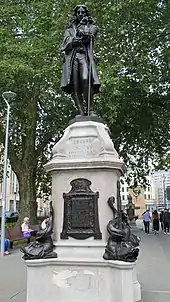 |
Bristol | The statue of Edward Colston, a slave trader, was toppled and thrown into the Bristol Harbour by protesters. | [10] |
| Statue of James II, Trafalgar Square | 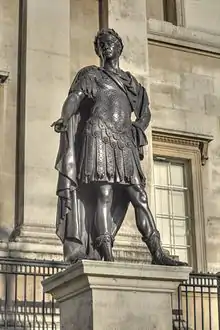 |
Trafalgar Square, London | The Duke of York James, later James II of England, was the principal Governor of the Royal African Company and its largest shareholder.[11] According to historians the Royal African Company "shipped more enslaved African women, men and children to the Americas than any other single institution during the entire period of the transatlantic slave trade." | [12] |
| Statue of Robert Milligan | 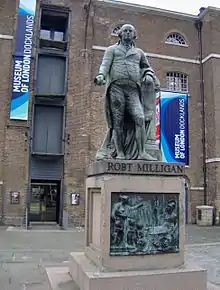 |
London | Statue of Robert Milligan, Scottish merchant and slave trader, outside the Museum of London Docklands. It was removed following a request from the Canal & River Trust. | [13] |
| Statue of Robert Geffrye |  |
London | English merchant who made part of his wealth from slavery, and part-owned a slave ship. A petition was raised for the removal of his statue outside the Museum of the Home; the Museum elected to "reinterpret and contextualise" the statue in its current location. | [14] |
London removal commission
In June 2020 the Mayor of London, Sadiq Khan, established the Commission for Diversity in the Public Realm to "review and improve diversity across London's public realm to ensure the capital's landmarks suitably reflect London's achievements and diversity".[15] Khan said "When you look at the public realm – street names, street squares, murals – not only are there some of slavers that I think should be taken down, and the commission will advise us on that, but actually we don’t have enough representation of people of colour, black people, women, those from the LGBT community."[16]
Khan also announced a pledge to create a National Slavery museum or memorial.[1]
See also
References
- "Robert Milligan: Slave trader statue removed from outside London museum". BBC News. 9 June 2020. Archived from the original on 9 June 2020. Retrieved 9 June 2020.
- Historic England, "Sir John Cass College (1064654)", National Heritage List for England, retrieved 8 June 2020
- "Statue: Sir John Cass statue – Jewry Street". London Remembers. Archived from the original on 10 June 2020. Retrieved 9 June 2020.
- Historic England, "Sir John Cass School (1285969)", National Heritage List for England, retrieved 8 June 2020
- Vicary, Tim. "Sir Francis Drake and the African Slaves". English Historical Fiction Authors. Archived from the original on 22 August 2017. Retrieved 13 June 2020.
- Green, Alex. "Petition calls for removal of Sir Francis Drake statue from Plymouth Hoe". Plymouth Live. Archived from the original on 10 June 2020. Retrieved 13 June 2020.
- Historic England, "Statue of Sir Francis Drake (1326211)", National Heritage List for England, retrieved 13 June 2020
- "Guy's Hospital considers taking down controversial statue of businessman who profited from slavery". ITV News. 9 June 2020. Archived from the original on 10 June 2020. Retrieved 9 June 2020.
- Historic England, "Statue of Thomas Guy, founder of Guy's Hospital, in centre of forecourt (1385879)", National Heritage List for England, retrieved 8 June 2020
- Siddique, Haroon (7 June 2020). "BLM protesters topple statue of Bristol slave trader Edward Colston". The Guardian. Archived from the original on 7 June 2020. Retrieved 7 June 2020.
- "Archived copy". Archived from the original on 27 September 2020. Retrieved 27 September 2020.CS1 maint: archived copy as title (link)
- "Legacy of Slavery Working Party recommendations". Jesus College, Cambridge. Archived from the original on 26 July 2020. Retrieved 27 September 2020.
- Burford, Rachael (9 June 2020). "Statue of 18th century slaver Robert Milligan in east London removed after pressure from campaigners". Evening Standard. London. Archived from the original on 10 June 2020. Retrieved 22 June 2020.
- "Museum of the Home to keep Sir Robert Geffrye statue". BBC News. 30 June 2020. Archived from the original on 27 September 2020. Retrieved 29 August 2020.
- "Mayor unveils commission to review diversity of London's public realm". Mayor of London. Archived from the original on 22 June 2020. Retrieved 22 June 2020.
- Morris, Nigel (9 June 2020). "Sadiq Khan says London slave trader statues could be pulled down after review". inews.co.uk. Archived from the original on 10 June 2020. Retrieved 10 June 2020.
Further reading
- Dresser, Madge (1 October 2007), "Set in Stone? Statues and Slavery in London", History Workshop Journal, 64 (1), pp. 162–199, doi:10.1093/hwj/dbm032, JSTOR 25472939
- Bennett, Catherine (27 September 2020). "With its slavery list, the National Trust makes a welcome entry to the 21st century". The Guardian.
External links
- https://www.toppletheracists.org - website documenting UK statues and monuments commemorating persons believed/alleged to have had ties to the slave trade (among other racist associations)